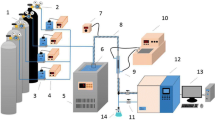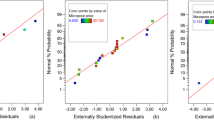Abstract
Mangosteen shell-derived activated carbons (ACs) were prepared by potassium hydroxide (KOH) activation for refining crude biodiesel derived from the transesterification of waste cooking oil and methanol via an alkali catalyst. Effects of the KOH/char (w/w) ratio (0.50–1.50), activation temperature (500–900 °C), adsorption time (15–180 min) and dosage of activated carbon (3–11 g/L) on the efficiency of the adsorptive refining of biodiesel were explored. The AC prepared at a KOH/char (w/w) ratio of 1.25 at 800 °C exhibited the best ability to remove impurities contained in the crude biodiesel, and enhanced the purity of the biodiesel by up to 97.18 wt% at a dosage of 9 g/L and 120 min adsorption time. This was better than that refined by the conventional wet washing method (96.03 wt%). Equilibrium adsorption data fitted well with Freundlich isotherms, and the adsorption mechanism was controlled by the transport of impurities from the bulk solution to the surface of the AC.








Similar content being viewed by others
References
Moraes MSA, Krause LC, Espinosa da Cunha M, Faccini CS, Weber de Menezes E, Veses RC, Rodrigues MRA, Caramão EB (2008) Tallow biodiesel: properties evaluation and consumption tests in a diesel engine. Energ Fuel 22:1949–1954
McNeill J, Kakuda Y, Kamel B (1986) Improving the quality of used frying oils by treatment with activated carbon and silica. J Am Oil Chem Soc 63:1564–1567
Berrios M, Skelton RL (2008) Comparison of purification methods for biodiesel. Chem Eng J 144:459–465
Suehara K, Kawamoto Y, Fujii E, Kohda J, Nakano Y, Yano Y (2005) Biological treatment of wastewater discharged from biodiesel fuel production plant with alkali-catalyzed transesterification. J Biosci Bioeng 100:437–442
Department of Alternative Energy Development and Efficiency. Ministry of Energy. [Online 2015] http://www.dede.go.th/dede/index.php?option=com_content&view=article&id=898&Itemid=123&lang=th
Stojković IJ, Stamenković OS, Povrenović DS, Veljković VB (2014) Purification technologies for crude biodiesel obtained by alkali-catalyzed transesterification. Renew Sustain Energy Rev 32:1–15
Faccini CS, Espinosa da Cunha M, Moraes MSA, Krause LC, Manique MC, Rodrigues MRA, Benvenutti EV, Caramão EB (2011) Dry washing in biodiesel purification: a comparative study of adsorbents. J Brazil Chem Soc 22(3):558–563
Manique MC, Faccini CS, Onorevoli B, Benvenutti EV, Caramã EB (2012) Rice husk ash as an adsorbent for purifying biodiesel from waste frying oil. Fuel 92:56–61
Wang Y, Wang X, Liu Y, Ou S, Tan Y, Tang S (2009) Refining of biodiesel by ceramic membrane separation. Fuel Process Technol 90:422–427
Nur H, Snowden MJ, Cornelius VJ, Mitchell JC, Harvey PJ, Ben LS (2009) Colloidal microgel in removal of water from biodiesel. Colloid Surfaces A 335:133–137
Ozgul-Yucel S, Turkay S (2003) Purification of FAME by rice hull ash adsorption. J Am Oil Chem Soc 80:373–376
Manuale DL, Greco E, Clementz A, Torres GC, Vera CR, Yori JC (2014) Biodiesel purification in one single stage using silica as adsorbent. Chem Eng J 256:372–379
Predojevic ZJ (2008) The production of biodiesel from waste frying oils: a comparison of different purification steps. Fuel 87:3522–3528
Fadhil AB, Dheyab MM, Abdul-Qader AY (2012) Purification of biodiesel using activated carbons produced from spent tea waste. J Assoc Arab Univ Bas Appl Sci 11:45–49
Kandiyoti R, Lazaridis JL, Dyrvold B, Ravindra C (1984) Pyrolysis of a ZnCl2-impregnated coal in an inert atmosphere. Fuel 63:1583–1587
Lillo-Raodenas MA, Cazorla-Amoros D, Linares-Solano A (2003) Understanding chemical reactions between carbons and NaOH and KOH: an insight into the chemical activation mechanism. Carbon 41:267–275
Teng H, Yeh TS, Hsu LY (1998) Preparation of activated carbon from bituminous coal with phosphoric acid activation. Carbon 36(9):1387–1395
Guo J, Lua AC (2003) Surface functional groups on oil-palm-shell adsorbents prepared by H3PO4 and KOH activation and their effects on adsorptive capacity. Chem Eng Res Design 81:585–590
ASTM International. ASTM D3172: Standard Practice for Proximate Analysis of Coal and Coke. http://www.astm.org/Standards/D3172
Tessmer CH, Vidic RD, Uranowski LJ (1997) Impact of oxygen-containing surface functional groups on activated carbon adsorption of phenols. Environ Sci Technol 31:1872–1879
Chen X, Jeyaseelan S, Graham N (2002) Physical and chemical properties study of the activated carbon made from sewage sludge. Waste Manag 22:755–760
British Standards Institution. EN 14103: fat and oil derivatives. Fatty acid methyl esters (FAME). Determination of ester and linolenic acid methyl ester contents. http://shop.bsigroup.com/ProductDetail/?pid=000000000030207061
ASTM International. ASTM D 664: standard test method for acid number of petroleum products by potentiometric titratio. http://www.astm.org/Standards/D664
Van Gerpen J, Shanks B, Pruszko R, Clements D, Knothe G (2004) Biodiesel analytical methods. Subcontractor report
Rutz D, Janssen R. Overview and recommendations on biofuel standards for transport in the EU. Project: BiofuelMarketplace (EIE/05/022/SI2.420009)
ISO store. Purified glycerol for industrial use—determination of density at 20 degrees C (ISO2099-1972). http://www.iso.org/iso/iso_catalogue/catalogue_tc/catalogue_detail.htm?csnumber=6887
ASTM International. ASTM D 445: standard test method for kinematic viscosity of transparent and opaque liquids (and calculation of dynamic viscosity). http://www.astm.org/Standards/D445
ASTM International. ASTM D 93: Standard Test Methods for Flash Point by Pensky-Martens Closed Cup Tester. http://www.astm.org/Standards/D93
Ros A, Lillo-Ródenas MA, Fuente E, Montes-Morán MA, Martín MJ, Linares-Solano A (2006) High surface area materials prepared from sewage sludge-based precursors. Chemosphere 65:132–340
British Standards Institution. EN 14214: Automotive fuels. Fatty acid methyl esters (FAME) for diesel engines. Requirements and test methods. http://shop.bsigroup.com/ProductDetail/?pid=000000000030217517
Yang T, Lua AC (2003) Characteristics of activated carbons prepared from pistachio-nut shells by potassium hydroxide activation. Micropor Mesopor Mater 63:113–124
Hunsom M, Autthanit C (2013) Adsorptive purification of crude glycerol by sewage sludge-derived activated carbon prepared by chemical activation with H3PO4, K2CO3 and KOH. Chem Eng J 229:334–343
Laine J, Calafat A (1991) Factors affecting the preparation of activated carbons from coconut shell catalysed by potassium. Carbon 29:949–953
Yu GX, Lu SX, Chen H, Zhu ZH (2005) Thermal regeneration of activated carbon saturated with p-nitrophenol. Carbon 43:2285–2293
Puziy AM, Poddubnaya OI, Martı́nez-Alonso A, Suárez-Garcı́a F, Tascón JMD (2002) Synthetic carbon activated with phosphoric acid: II. Porous structure. Carbon 40(9):1507–1519
Liu S, Musuku SR, Adhikari S, Fernando S (2009) Adsorption of glycerol from biodiesel washwaters. Environ Technol 30(5):505–510
Otowa T, Nojima Y, Miyazaki T (1997) Development of KOH activated high surface area carbon and its application to drinking water purification. Carbon 35:1315–1319
Lillo-Ródenas MA, Juan-Juan J, Cazorla-Amorós D, Linares-Solano A (2004) About reactions occurring during chemical activation with hydroxides. Carbon 42(7):1371–1375
Jankowska H, Swiatkowski A, Choma J (1991) Active carbon. Ellis Horwood, New York
Gupta S, Babu BV (2009) Removal of toxic metal Cr(VI) from aqueous solutions using sawdust as adsorbent: equilibrium, kinetics and regeneration studies. Chem Eng J 150(2–3):352–365
Vasconcelos HL, Camargo TP, Goncalve NS, Neves A, Laranjeira MCM, Favere WT (2008) Chitosan crosslinked with a metal complexing agent: synthesis, characterization and copper (II) ions adsorption. React Funct Polym 68:572–579
Hall KR, Eagleton LC, Acrivos A, Vermeulen T (1966) Pore and solid diffusion kinetics in fixed bed adsorption under constant pattern conditions. Indust Eng Chem Fund 5:212–218
Bu J, Loh G, Gwie CG, Dewiyanti S, Tasrif M, Borgna A (2011) Desulfurization of diesel fuels by selective adsorption on ACs: competitive adsorption of polycyclic aromatic sulfur heterocycles and polycyclic aromatic hydrocarbons. Chem Eng J 166:207–217
Vazquez I, Rodrıguez-Iglesias J, Maranon E, Castrillon L, Alvarez M (2007) Removal of residual phenols from coke wastewater by adsorption. J Hazard Mater 147:395–400
Ho YS, Mckay G (1999) Comparative sorption kinetic studies of dyes and aromatic compounds onto fly ash. J Environ Sci Health A 34:1179–1204
Ahmad AL, Sumathi S, Hameed BH (2005) Adsorption of residue oil from palm oil mill effluent using powder and chitosan flake: equilibrium and kinetic studies. Water Res 39:2483–2894
Chiou MS, Li HY (2002) Equilibrium and kinetic modeling of adsorption of reactive dye on cross-linked chitosan beads. J Hazard Mater 93:233–248
Zhang X, Bai R (2003) Mechanisms and kinetics of humic acid adsorption onto chitosan-coated granules. J Colloid Interf Sci 264:30–38
Acknowledgments
The authors would like to thank the CU Graduate School Thesis Grant, the Ratchadapisek Sompoch Endowment Fund, Chulalongkorn University (Sci-Super II GF_58_08_23_01) and the Thailand Research Fund (IRG5780001) for financial support. Also, we thank Dr.Robert D.J. Butcher for comments, suggestions and checking the grammar.
Author information
Authors and Affiliations
Corresponding author
About this article
Cite this article
Pangsupa, W., Hunsom, M. Preparation of Mangosteen Shell-Derived Activated Carbon Via KOH Activation for Adsorptive Refining of Crude Biodiesel. J Am Oil Chem Soc 93, 1697–1708 (2016). https://doi.org/10.1007/s11746-016-2898-2
Received:
Revised:
Accepted:
Published:
Issue Date:
DOI: https://doi.org/10.1007/s11746-016-2898-2




